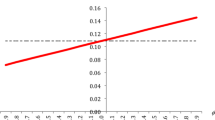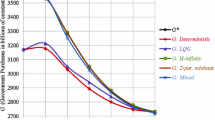Summary (Abstract)
It is argued in this paper that an independent control of target variables over time in continuous dynamic macroeconomic systems may not be achievable even though Aoki's well-known rank test for target path controllability is satisfied. It is shown that in many dynamical systems impulse controls are needed to steer the targets along arbitrarily given time paths. Such controls are not admissible from the macroeconomic point of view. By means of the structure algorithm by Silverman and Payne (1971) conditions for target path controllability that depend on the choice of the admissible spaces for the target and the instrument variables, are derived.
Similar content being viewed by others
References
M. Aoki (1975): On a Generalization of Tinbergen's Condition in the Theory of Policy to Dynamic Models, Review of Economic Studies42, pp. 293–296.
M. Aoki (1976): Optimal Control and System Theory in Dynamic Economic Analysis, New York, Oxford, Amsterdam.
M. Aoki and M. Canzoneri (1979): Sufficient Conditions for Control of Target Variables and Assignment of Instruments in Dynamic Macroeconomic Models, International Economic Review20, pp. 605–616.
R. W. Brockett (1965): Poles, Zeros, and Feedback: State Space Interpretation, IEEE Transactions on Automatic Control AC-10, pp. 129–135.
R. W. Brockett and M. D. Mesarović (1965): The Reproducibility of Multivariable Systems, Journal of Mathematical Analysis and Applications11, pp. 548–563.
W. H. Buiter and M. Gersovitz (1981): Issues in Controllability and the Theory of Economic Policy, Journal of Public Economics15, pp. 33–43.
A. H. Hughes Hallett and H. Rees (1983): Quantitative Economic Policies and Interactive Planning, Cambridge et al.
R. E. Kalman (1960): Contributions to the Theory of Optimal Control, Proceedings of the Mexico City Conference on Ordinary Differential Equations, 1959, Bol. Socied. Mat. Mexicana5, pp. 102–119.
V. Lovass-Nagy, R. J. Miller and D. L. Powers (1976): On Output Control in the Servomechanism Sense, International Journal of Control24, pp. 435–440.
V. Lovass-Nagy R. J. Miller, and D. L. Powers (1978): Further Results on Output Control in the Servomechanism Sense, International Journal of Control27, pp. 133–138.
L. Nyberg and S. Viotti (1978): Controllability and the Theory of Economic Policy. A Critical View, Journal of Public Economics9, pp. 73–81.
S. G. Pandit and S. G. Deo (1982): Differential Systems Involving Impulses, Berlin, Heidelberg, New York.
A. J. Preston (1974): A Dynamic Generalization of Tinbergen's Theory of Policy, Review of Economic Studies41, pp. 65–74.
A. J. Preston and A. R. Pagan (1982): The Theory of Economic Policy. Statics and Dynamics, Cambridge et al.
A. J. Preston and E. Sieper (1977): Policy Objectives and Instrument Requirements for a Dynamic Theory of Policy, in: J. D. Pitchford and S. J. Turnovsky, eds., Applications of Control Theory to Economic Analysis, Amsterdam, New York, Oxford, pp. 215–253.
M. K. Sain and J. L. Massey (1969): Invertibility of Linear Time-Invariant Dynamical Systems, IEEE Transactions on Automatic Control AC-14, pp. 141–149.
L. M. Silverman and H. J. Payne (1971): Input-Output Structure of Linear Systems with Applications to the Decoupling Problem, SIAM Journal of Control9, pp. 199–233.
S. P. Singh (1970): A Note on Inversion of Linear Systems, IEEE Transactions on Automatic Control AC-15, pp. 492–493.
J. Tinbergen (1952): On the Theory of Economic Policy, Amsterdam. H.-W. Wohltmann (1981): Complete, Perfect, and Maximal Controllability of Discrete Economic Systems, Zeitschrift für Nationalökonomie41, pp. 39–58.
H.-W. Wohltmann (1984): A Note on Aoki's Conditions for Path Controllability of Continuous-Time Dynamic Economic Systems, Review of Economic StudiesLI, pp. 343–349.
H.-W. Wohltmann and W. Krömer (1984): Sufficient Conditions for Dynamic Path Controllability of Economic Systems, Journal of Economic Dynamics and Control7, pp. 315–330.
L. A. Zadeh and C. A. Desoer (1963): Linear System Theory. The State Space Approach, New York et al.
Author information
Authors and Affiliations
Additional information
The author is grateful to Professor Dr. Helmut Kuhn, Göttingen, and two anonymous referees for valuable comments on an earlier draft of this paper.
Rights and permissions
About this article
Cite this article
Wohltmann, HW. On the controllability of continuous-time macroeconomic models. Zeitschr. f. Nationalökonomie 45, 47–66 (1985). https://doi.org/10.1007/BF01283154
Received:
Revised:
Issue Date:
DOI: https://doi.org/10.1007/BF01283154




